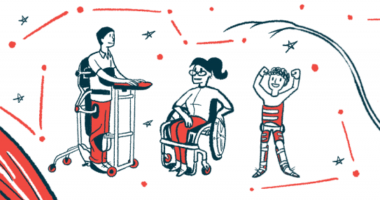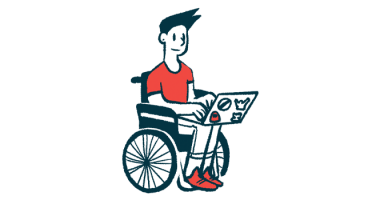Having a caregiver provide PT at home a boost for patients
Learning needed physical therapy maneuvers can help continue progress

Michael Morale and his therapist Emily Jones sit on the physical therapy table working on sitting balance at ClearCut Ortho in Fort Worth, Texas. (Courtesy of Michael Morale)
When a patient attends physical therapy, a home exercise program is typically assigned for completion outside of the clinic. In various settings and for different diagnoses, patients may be seen at a frequency ranging from once every few weeks to three times weekly. For patients who are not seen as often, a higher number of activities may need to be performed at home to achieve progress toward goals, as compliance is a significant factor in progress.
Michael, a patient I work with who has spinal muscular atrophy, is seen once a week in our clinic. Treatment looks different for him every other week. He is transferred to a therapy table one week for stretching, possible dry needling, or other activities that can’t be done in his chair. The other week, he stays in his chair. He has lymphatic drainage performed on his legs, stretching of his lower extremities, and some manual therapy to reduce the increased tension in his thoracic and cervical spine, such as cupping.
With a caregiver’s help, there are physical therapy moves that can be performed at home in between sessions to promote independence and improve function. There are self-cupping cup sets easily accessible for purchase. Caregivers can observe a session and be trained in applying cups to increase blood flow and reduce tension in muscle groups. This procedure can be performed on multiple body parts for various therapeutic reasons provided it is applied safely with proper training and observation.
Another activity that can be performed with some training is lymphatic drainage. Although this is a skilled and specific type of massage, some things can be done to help stimulate the lymph nodes and improve circulation in areas such as the groin and armpits. Caregivers can perform light circles in the groin and armpits to stimulate the lymph nodes to improve drainage around those areas. Elevating the lower extremities and performing activities, such as gently pumping the ankle back and forth, can also help stimulate and reduce swelling in the legs and feet. Compression stockings can be applied once swelling has been reduced to keep swelling from pooling in the legs and feet.
Stretching of the legs and arms, performed gently, can also be done by caregivers at home to improve comfort and reduce tension between physical therapy sessions. This can be done either while the person is sitting in their wheelchair, while they are in bed, or a combination of both. This is a good opportunity for the caregiver to come into a physical therapy session, watch, and practice gentle stretching with guidance from the therapist.
Visiting a physical therapy clinic once or twice a week is beneficial. Still, numerous hours and days are spent outside the clinic, where activities can be performed to reinforce progress. Maintaining a good relationship and effective communication with a patient and their caregiver is essential to ensure a seamless transition from the clinic to home. Allow time for questions and a comfortable environment for learning. If you can provide these things, your patient will thrive and have more support at home for progression.
Patient perspective
I consider myself fortunate because I have lived with caregivers who are available all the time. While this is an expensive option, it’s more of a necessity than it is a luxury. The state I live in does not cover the cost of live-in caregivers, so this out-of-pocket expense is truly justifiable.
I recently had a severe chest infection, and my caregivers were essential in helping me. To get enough force to expel the extra mucus and phlegm in my lungs, my caregivers would bring my knees up to my chest and push, which allowed me to get enough force to cough with more pressure than if I tried to do it myself. Without them, I would’ve ended up in the hospital for an extended period.
They also help with the exercises I do each day to improve my flexibility and range of motion. While I try to be as self-sufficient as possible, my caregiver has put in extra hours during my illness to ensure my safety and health.




